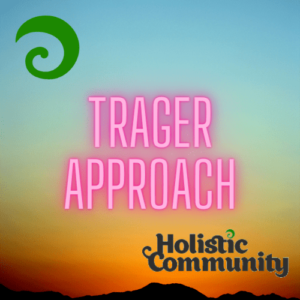 The Trager Approach is a mind-body approach to movement education. It is a system of gentle, rhythmic movement and touch aimed at facilitating deep relaxation, increased physical mobility, and promoting the body’s optimal performance. There are several aspects of the approach: one in which the client passively receives the movement work on a padded table from a Trager practitioner; and another aspect, in which the client is taught to actively explore comfortable, free movement for themselves, is called Mentastics. Underlying to the basic aim of psychophysical integration in the Trager Approach, is a form of neuromuscular re-education called Reflex Response. This aspect of Dr.Trager’s work actively involves the client in awakening the connection between mind and body.
The Trager Approach is a mind-body approach to movement education. It is a system of gentle, rhythmic movement and touch aimed at facilitating deep relaxation, increased physical mobility, and promoting the body’s optimal performance. There are several aspects of the approach: one in which the client passively receives the movement work on a padded table from a Trager practitioner; and another aspect, in which the client is taught to actively explore comfortable, free movement for themselves, is called Mentastics. Underlying to the basic aim of psychophysical integration in the Trager Approach, is a form of neuromuscular re-education called Reflex Response. This aspect of Dr.Trager’s work actively involves the client in awakening the connection between mind and body.
A session typically lasts from 20/40 minutes to one and a half hours. The client wears underwear or light, loose clothing and lies on a padded table in a comfortable environment. The practitioner makes touch-contact with the client, both as a whole and partly with individual limbs and segments. The central feature of the work is the sensory quality of the physical contact consisting of gently coaxing elongations, softly penetrating compressions, and a pleasurable rhythmic rocking, sending resonating ripples throughout the body’s fluid structure.
After getting up from the table, the client is given instruction in the use of Mentastics, a system of simple, effortless movement sequences developed by Dr. Trager to maintain and enhance the sense of lightness, freedom, and flexibility that was instilled by the table work. This extends the effects of the lessons learned in the session and gives something useful to explore in the context of daily living.
The Trager Approach is reported to help release or re-balance physical and mental patterning, to facilitate deep relaxation, and to increase physical mobility and functional awareness. The Trager Approach has been reported to ease or help manage a wide range of conditions including: stress, back and neck pain, limited movement, muscle spasms, headaches, fibromyalgia, multiple sclerosis, Parkinson’s disease, post-polio syndrome, cerebral palsy, physical/emotional trauma, sports and other injuries. Beyond physical problems and experienced-limitation, competitive athletes, dancers musicians, singers, and those interested in personal growth have benefited from the awarenesses gained in Trager movement education.
______________________________________________________
From Wikipedia, the free encyclopedia.
